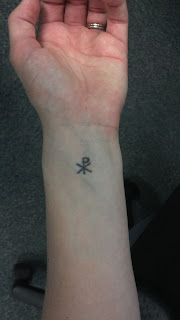I was introduced to Joel and Tracy back in May while I was at college for summer session. What stood out first to me was their passion to serve God. This passion led them to recently move into the southwest quadrant of Springfield, Ohio, an area with a marred past but a hopeful future.
And Joel and Tracy as well as ministries, churches and organizations in the area are the ones bringing such hope to the community. Joel and Tracy’s focus in their outreach is influencing young people for the Lord. To do this, they plan to start a ministry of their own to encourage and enable youth in the area to express themselves in art of all kinds. Joel says this type of outreach is important because when the economy is tough in areas, one of the first things to be pulled from schools is art. He also said this is tragic because for many talented youth, art is their way out of such hopeless circumstances.
With trying to reach out to teens in tough situations, Joel and Tracy know it is important to be relevant. Joel especially can connect with youth because of life experiences he has had as well as his talents in hip hop, painting and drawing. Another thing that makes them relevant to the area they are in is their tattoos.
When Joel met Tracy, he had one tattoo. Though Tracy wasn’t a huge fan of tattoos, she says she didn’t mind the one. The tattoo was of the words “agape love” (which is a biblical concept of God’s unconditional love for mankind) and a dove. Joel says he got this tattoo because before he became a follower of Christ he treated people poorly, so he wanted a reminder of how he should treat people, to contrast how he used to be.
Then when Tracy started warming up to tattoos, Joel says he took advantage of the opportunity by getting a few more, including one he actually got with Tracy. So now Joel has six tattoos and Tracy has one. The tattoo they got together was the monogram of two superimposed Greek letters, chi and rho, because these are the first two letters for the Greek word for Christ. Joel and Tracy say this symbol is important to them because it was a mark used by early Christians persecuted in ancient Rome as a sign of brotherhood/sisterhood in their devotion to Christ.
Joel's other tattoos (all of which he designed) are as follows:
He has a cross with "YHWH," the Hebrew name for God of the Bible. Joel says he got this because he is a fan of the Bible and theology (which is appropriate considering he is in seminary).
He also has the Bible reference of Song of Songs 2:2 on his forearm for Tracy. The verse reads, "Like a lily among thorns is my darling among the maidens." He says he chose this because he wanted something different than her name on his body and because it serves as a conversation piece with other guys, in that he is able to explain how women should be treated in relationships--with love, respect and honor.
Next, Joel got the words "Jehovah-jireh," which is the anglicized way of expressing "YHWH will provide." Along with the name is the Bible reference of Genesis 22:14 where God provided for the Jewish forefather Abraham. Joel says he got this tattoo after a time in his life where he had to "swallow his pride" and just trust God's ways of providing for him.
Lastly, Joel has the Latin phrase "Sola Scriptura" on the inside of his left bicep. This phrase was the rallying cry against the Catholic Church during the Revolution, in that the Protestant reformers held to the doctrine that the Bible contains all knowledge necessary for salvation and holiness. Just like with Joel's YHWH tattoo, his love for Scripture influenced him to get this tattoo.
Joel says that if it were up to him, he would be covered in tattoos from his waist up to his neck, down to his fingertips. But since he has a wife, her family and others to consider, he is going to get one more, oddly enough at his mother-in-law's insistence; she thinks seven tattoos is better than six because seven is the number of completion. He is still trying to figure out what to get, but he thinks it will probably relate to the ministry he and his wife are going to start.
I hope you all enjoyed those stories behind the ink of a sincerely godly couple. Next week's post is even a surprise to me at this point, but I will try to get something up. Thank you for reading, and I hope to see you back here!














